Neural Gas Network Optimization Using Improved OAT Algorithm for Oil Spill Detection in Marine Radar Imagery
Abstract
1. Introduction
2. Materials and Methods
2.1. Dataset
2.2. NGN-OAT Oil Film Segmentation Algorithm
2.2.1. The NGN Model
- (1)
- Grid initialization: the random initialization of the weight vector:where N is the preset number of neurons.
- (2)
- For each input sample x, calculate the distance from all neurons and sort
- (3)
- Learning rate and domain parameters decay with the number of iterations:where represents the total time step of the run, is the current iteration progress, represents the initial lifespan threshold of neuronal connections. is the threshold for the termination lifespan of neuronal connections.
- (4)
- Update weights of the sorted neurons:where is the sorting position of neuron i (starts from 0).
- (5)
- In the training process of the network, the connection between the nearest two neurons is established by setting the connection matrix. Then, the aging process of neuronal connections is simulated by increasing the values of relevant elements in the connection matrix. Finally, if the age of a connection surpasses the predefined threshold, T(t), the corresponding element in the connection matrix is set to 0, effectively pruning these aged connections. Dynamic synaptic pruning enhances data distribution adaptation. Topological neuron relationships boost clustering efficacy.
- (6)
- After the final weights are re-quantified, the model will map each pixel to the nearest neuron to generate the segmented image.
2.2.2. OAT Optimization Algorithm
- (1)
- Preprocess the image and normalize the image data:where I(x, y) represents the pixel value of the original gray image.
- (2)
- Calculate the histogram peak of the normalized image:where hist(b) is the total number of pixel values falling in interval b.
- (3)
- The fitness function, F(t), is defined to evaluate the segmentation threshold, t. The function takes into account two key indicators: intra class variance and regional connectivity. Intra class variance is used to measure the uniformity of pixel values in each region after segmentation. Regional connectivity ensures the continuity and consistency of segmentation results in space. Through threshold t, the normalized image is binarized to obtain :
- (4)
- For each generation, generate candidate seeds.where , .
- (5)
- Output the optimal threshold, t*, and segmentation results:
2.2.3. OAT-NGN Hybrid Strategy
- (1)
- Global and local collaborative optimization
- (2)
- Spatial information integration
| Algorithm 1. Pseudo code of the NGN-OAT Oil Segmentation algorithm |
| Input: Oil Spill Image (Org) Function: Initialize Parameters Calculate histogram of imgData Set initThresh to the most frequent intensity value N = min (20, max (5, round(numel(imgData)/10,000)) // Number of neurons Return N, initThresh Function: Main Segmentation NGNnetwork = GasNN-Oat (imgData, params) Return segmented image Core Function: GasNN-Oat (X, params) Extract parameters from params Shuffle input data X Initialize weights w from initThresh and N Repeat for it = 1 to MaxIt: Update parameters: epsilon, lambda, T If oat_active and mod (it, oat_updateInterval) == 0: Generate seeds and evaluate scores in parallel Update best weights if score improves Process data in batches to update weights w Return w Function: oatFitness (X, w) Minimize distance to weights w and compute internal variance Return fitness score Function: fastDist (X, Y) Calculate distance matrix D between X and Y Return D Output: Segmented Image (segmented) |
2.3. Evaluation Indicators
3. Results
3.1. Oil Film Segmentation Results
3.2. Evaluation of Experimental Results
4. Discussion
4.1. Comparison with NGN Model
4.2. Comparison with Other Algorithms
4.2.1. Comparison with Global Adaptive Threshold Method
4.2.2. Comparison with Local Adaptive Threshold Method
4.2.3. Comparison with Other Machine Learning Algorithms
4.2.4. Quantitative Comparative Analysis
4.3. Limitations of Marine Radar Oil Spill Monitoring Technology
4.4. Potentiality of NGN-OAT Model in High-Frequency Ground Wave Radar Data
5. Conclusions
Author Contributions
Funding
Data Availability Statement
Conflicts of Interest
References
- Yin, C. International Law Regulation of Offshore Oil and Gas Exploitation. Environ. Impact. Assess. Rev. 2021, 88, 106551. [Google Scholar] [CrossRef]
- Zhou, X.; Ruan, X.; Wang, H.; Zhou, G. Exploring Spatial Patterns and Environmental Risk Factors for Global Maritime Accidents: A 20-Year Analysis. Ocean Eng. 2023, 286, 115628. [Google Scholar] [CrossRef]
- Novaglio, C.; Bax, N.; Boschetti, F.; Emad, G.R.; Frusher, S.; Fullbrook, L.; Hemer, M.; Jennings, S.; van Putten, I.; Robinson, L.M.; et al. Deep Aspirations: Towards a Sustainable Offshore Blue Economy. Rev. Fish Biol. Fish. 2022, 32, 209–230. [Google Scholar] [CrossRef] [PubMed]
- Yu, J.; Zhou, D.; Yu, M.; Yang, J.; Li, Y.; Guan, B.; Wang, X.; Zhan, C.; Wang, Z.; Qu, F. Environmental Threats Induced Heavy Ecological Burdens on the Coastal Zone of the Bohai Sea, China. Sci. Total Environ. 2021, 765, 142694. [Google Scholar] [CrossRef] [PubMed]
- Chen, J.; Di, Z.; Shi, J.; Shu, Y.; Wan, Z.; Song, L.; Zhang, W. Marine Oil Spill Pollution Causes and Governance: A Case Study of Sanchi Tanker Collision and Explosion. J. Clean. Prod. 2020, 273, 122978. [Google Scholar] [CrossRef]
- Zhang, W.; Li, C.; Chen, J.; Wan, Z.; Shu, Y.; Song, L.; Xu, L.; Di, Z. Governance of Global Vessel-Source Marine Oil Spills: Characteristics and Refreshed Strategies. Ocean Coast. Manag. 2021, 213, 105874. [Google Scholar] [CrossRef]
- Ma, X.; Xu, J.; Pan, J.; Yang, J.; Wu, P.; Meng, X. Detection of Marine Oil Spills from Radar Satellite Images for the Coastal Ecological Risk Assessment. J. Environ. Manag. 2023, 325, 116637. [Google Scholar] [CrossRef]
- Wang, L.; Niu, W.; Ding, L.; Zhao, Z. A Bibliometric Review on Marine Economy: Current Status, Development and Future Directions. Mar. Policy 2023, 155, 105705. [Google Scholar] [CrossRef]
- Fernández-Macho, J. Forecasting Marine Spill Risk along the U.S. Pacific Coasts. Mar. Pollut. Bull 2024, 198, 115826. [Google Scholar] [CrossRef]
- Mogollón, R.; Arellano, C.; Villegas, P.; Espinoza-Morriberón, D.; Tam, J. REPSOL Oil Spill off Central Perú in January 2022: A Modeling Case Study. Mar. Pollut. Bull 2023, 194, 115282. [Google Scholar] [CrossRef]
- Oil Tanker Collision and Fire in Gulf of Oman Caused by ‘Navigational Misjudgment’. Available online: https://www.thenationalnews.com/news/uae/2025/06/17/uae-coast-guard-rescues-24-crew-members-after-oil-tanker-collision-in-sea-of-oman (accessed on 5 July 2025).
- Zhang, C.; Zhu, J.; Mai, W.; Chen, Z.; Xie, Y.; Fu, S.; Xia, D.; Cai, C.; Zheng, W.; Liu, J.; et al. Satellite Remote Sensing-Implemented Nontargeted Screening of Emerging Contaminant Fingerprints in a River-to-Ocean Continuum through Interpretable Machine Learning: The Pivotal Intermediary Role of Dissolved Organic Matter. Environ. Sci. Technol. 2025, 59, 8714–8726. [Google Scholar] [CrossRef] [PubMed]
- Mokarram, M.; Pham, T.M. Environmental Monitoring of Oil Pollution in the Marine Waters Using Machine Learning and Remote Sensing. Adv. Space Res. 2025, 75, 6173–6187. [Google Scholar] [CrossRef]
- El Mahrad, B.; Newton, A.; Icely, J.D.; Kacimi, I.; Abalansa, S.; Snoussi, M. Contribution of Remote Sensing Technologies to a Holistic Coastal and Marine Environmental Management Framework: A Review. Remote Sens. 2020, 12, 2313. [Google Scholar] [CrossRef]
- Hengkai, L.; Feng, X.; Qin, L. Remote Sensing Monitoring of Land Damage and Restoration in Rare Earth Mining Areas in 6 Counties in Southern Jiangxi Based on Multisource Sequential Images. J. Environ. Manag. 2020, 267, 110653. [Google Scholar] [CrossRef] [PubMed]
- Shi, D.; Zou, J.; Liu, L.; Huang, F.; Li, L. Research Progress and Prospect of Super-Large Field-of-View Infrared Imaging Technology. Laser Optoelectron. Prog. 2025, 62, 1000004. [Google Scholar] [CrossRef]
- Sun, K.; Jiang, G.; Wang, N.; Yu, D.; Teng, J.; Gao, S.; Huang, J.; Zhao, Z.; Song, Y.; Xin, L.; et al. A Semantic Segmentation Network for Red Tide Detection Based on Enhanced Spectral Information Using HY-1C/D CZI Satellite Data. Mar. Pollut. Bull 2025, 215, 117813. [Google Scholar] [CrossRef]
- Wachmann, A.; Starko, S.; Neufeld, C.J.; Costa, M. Validating Landsat Analysis Ready Data for Nearshore Sea Surface Temperature Monitoring in the Northeast Pacific. Remote Sens. 2024, 16, 920. [Google Scholar] [CrossRef]
- Sun, C.; Li, J.; Liu, Y.; Pan, T.; Shi, K.; Cai, X. Synthesizing Landsat Images Using Time Series Model-Fitting Methods for China’s Coastal Areas against Sparse and Irregular Observations. GIsci. Remote Sens. 2024, 61, 2421574. [Google Scholar] [CrossRef]
- Shen, A.; Shao, J. Spectral Harmonization Landsat-8 and Sentinel-2A: The Matching Bands Adjustment before the Missing Bands Prediction Method. IEEE Trans. Geosci. Remote Sens. 2024, 62, 1–14. [Google Scholar] [CrossRef]
- Yan, L.; Roy, D.P. Using Landsat 8 and 9 Operational Land Imager (OLI) Data to Characterize Geometric Distortion and Improve Geometric Correction of Landsat Multispectral Scanner (MSS) Imagery. Remote Sens. Environ. 2025, 321, 114679. [Google Scholar] [CrossRef]
- St-Denis, F.; Tremblay, L.B.; Mahoney, A.R.; Takata-Glushkoff, K.P.L.M. Coastal Sea Ice Concentration Derived from Marine Radar Images: A Case Study from Utqiaġvik, Alaska. Remote Sens. 2024, 16, 3357. [Google Scholar] [CrossRef]
- Xu, J.; Liu, Z.; Hong, G.; Cao, Y. A New Machine-Learning-Based Calibration Scheme for MODIS Thermal Infrared Water Vapor Product Using BPNN, GBDT, GRNN, KNN, MLPNN, RF, and XGBoost. IEEE Trans. Geosci. Remote Sens. 2024, 62, 1–12. [Google Scholar] [CrossRef]
- Bondur, V.; Chernikova, V.; Chvertkova, O.; Zamshin, V. Spatiotemporal Variability of Anthropogenic Film Pollution in Avacha Gulf near the Kamchatka Peninsula Based on Synthetic-Aperture Radar Imagery. J. Mar. Sci. Eng. 2024, 12, 2357. [Google Scholar] [CrossRef]
- Yi, Y.; Chen, K.; Xu, J.; Luo, Q. Tracking the Dynamics of Salt Marsh Including Mixed-Vegetation Zones Employing Sentinel-1 and Sentinel-2 Time-Series Images. Remote Sens. 2025, 17, 56. [Google Scholar] [CrossRef]
- Welikanna, D.R.; Jin, S. A Data Driven Oil Spill Mapping Using GMM Clustering and Damping Ratio on X-Press Pearl Ship Disaster in the Indian Ocean. Mar. Pollut. Bull. 2024, 203, 116392. [Google Scholar] [CrossRef]
- Oluwadare, T.S.; Chen, D.; Oluwafemi, O.; Babadi, M.; Hossain, M.; Ibukun, O. Reconstructing Snow-Free Sentinel-2 Satellite Imagery: A Generative Adversarial Network (GAN) Approach. Remote Sens. 2024, 16, 2352. [Google Scholar] [CrossRef]
- Li, C.; Kim, D.-j.; Park, S.; Kim, J.; Song, J. A Self-Evolving Deep Learning Algorithm for Automatic Oil Spill Detection in Sentinel-1 SAR Images. Remote Sens. Environ. 2023, 299, 113872. [Google Scholar] [CrossRef]
- Fan, Y.; Rui, X.; Zhang, G.; Yu, T.; Xu, X.; Poslad, S. Feature Merged Network for Oil Spill Detection Using Sar Images. Remote Sens. 2021, 13, 3174. [Google Scholar] [CrossRef]
- Chen, F.; Balzter, H.; Ren, P.; Zhou, H. SRCNet: Seminal Image Representation Collaborative Network for Oil Spill Segmentation in SAR Imagery. IEEE Trans. Geosci. Remote Sens. 2024, 62, 1–18. [Google Scholar] [CrossRef]
- Zhu, Q.; Zhang, Y.; Li, Z.; Yan, X.; Guan, Q.; Zhong, Y.; Zhang, L.; Li, D. Oil Spill Contextual and Boundary-Supervised Detection Network Based on Marine SAR Images. IEEE Trans. Geosci. Remote Sens. 2022, 60, 5213910. [Google Scholar] [CrossRef]
- Cheng, L.; Li, Y.; Zhang, X.; Xie, M. An Analysis of the Optimal Features for Sentinel-1 Oil Spill Datasets Based on an Improved J–M/K-Means Algorithm. Remote Sens. 2022, 14, 4290. [Google Scholar] [CrossRef]
- Song, D.; Huang, Q.; Gao, H.; Wang, B.; Zhang, J.; Chen, W. Adaptive Oil Spill Detection Network for Scene-Based PolSAR Data Using Dynamic Convolution and Boundary Constraints. Int. J. Appl. Earth Obs. Geoinf. 2024, 130, 103914. [Google Scholar] [CrossRef]
- Ji, Y.; Wang, Y.; Sun, W.; Zhang, H.; Li, F.; Huang, W. Target Monitoring Capability Analysis for Shipborne HFSWR under Different Platform Motions. IEEE Trans. Geosci. Remote Sens. 2024, 62, 1–17. [Google Scholar] [CrossRef]
- Lau, T.K.; Huang, K.H. A Timely and Accurate Approach to Nearshore Oil Spill Monitoring Using Deep Learning and GIS. Sci. Total Environ. 2024, 912, 169500. [Google Scholar] [CrossRef] [PubMed]
- Chen, R.; Jia, B.; Ma, L.; Xu, J.; Li, B.; Wang, H. Marine Radar Oil Spill Extraction Based on Texture Features and BP Neural Network. J. Mar. Sci. Eng. 2022, 10, 1904. [Google Scholar] [CrossRef]
- Liu, P.; Li, Y.; Liu, B.; Chen, P.; Xu, J. Semi-Automatic Oil Spill Detection on X-Band Marine Radar Images Using Texture Analysis, Machine Learning, and Adaptive Thresholding. Remote Sens. 2019, 11, 756. [Google Scholar] [CrossRef]
- Martinetz, T.; Schulten, K. A “Neural-Gas” Network Learns Topologies. In Artificial Neural Networks; Elsevier: Amsterdam, The Netherlands, 1991; pp. 397–402. [Google Scholar]
- Cottrell, M.; Hammer, B.; Hasenfuß, A.; Villmann, T. Batch and Median Neural Gas. Neural Netw. 2006, 19, 762–771. [Google Scholar] [CrossRef]
- Dirgová Luptáková, I.; Šimon, M.; Huraj, L.; Pospíchal, J. Neural Gas Clustering Adapted for Given Size of Clusters. Math. Probl. Eng. 2016, 2016, 9324793. [Google Scholar] [CrossRef]
- Qin, A.K.; Suganthan, P.N. Robust Growing Neural Gas Algorithm with Application in Cluster Analysis. Neural Netw. 2004, 17, 1135–1148. [Google Scholar] [CrossRef]
- Qin, A.K.; Suganthan, P.N. Enhanced Neural Gas Network for Prototype-Based Clustering. Pattern Recognit. 2005, 38, 1275–1288. [Google Scholar] [CrossRef]
- Wang, R.B.; Hu, R.B.; Geng, F.D.; Xu, L.; Chu, S.C.; Pan, J.S.; Meng, Z.Y.; Mirjalili, S. The Animated Oat Optimization Algorithm: A Nature-Inspired Metaheuristic for Engineering Optimization and a Case Study on Wireless Sensor Networks. Knowl. Based Syst. 2025, 318, 113589. [Google Scholar] [CrossRef]
- Huang, L.K.; Wang, M.J.J. Image Thresholding by Minimizing the Measures of Fuzziness. Pattern Recognit. 1995, 28, 41–51. [Google Scholar] [CrossRef]
- Goh, T.Y.; Basah, S.N.; Yazid, H.; Aziz Safar, M.J.; Ahmad Saad, F.S. Performance Analysis of Image Thresholding: Otsu Technique. Measurement 2018, 114, 298–307. [Google Scholar] [CrossRef]
- Ma, G.; Yue, X. An Improved Whale Optimization Algorithm Based on Multilevel Threshold Image Segmentation Using the Otsu Method. Eng. Appl. Artif. Intell. 2022, 113, 104960. [Google Scholar] [CrossRef]
- Tan, J.; Tang, Y.; Liu, B.; Zhao, G.; Mu, Y.; Sun, M.; Wang, B. A Self-Adaptive Thresholding Approach for Automatic Water Extraction Using Sentinel-1 SAR Imagery Based on OTSU Algorithm and Distance Block. Remote Sens. 2023, 15, 2690. [Google Scholar] [CrossRef]
- Najafi, M.H.; Salehi, M.E. A Fast Fault-Tolerant Architecture for Sauvola Local Image Thresholding Algorithm Using Stochastic Computing. IEEE Trans. Very Large Scale Integr. VLSI Syst. 2016, 24, 808–812. [Google Scholar] [CrossRef]
- Mohamed Razali, M.R.; Ahmad, N.S.; Mohd Zaki, Z.; Ismail, W. Region of Adaptive Threshold Segmentation between Mean, Median and Otsu Threshold for Dental Age Assessment. In Proceedings of the I4CT 2014—1st International Conference on Computer, Communications, and Control Technology, Langkawi, Malaysia, 2–4 September 2014; Institute of Electrical and Electronics Engineers Inc.: New York, NY, USA, 2014; pp. 353–356. [Google Scholar]
- Sauvola, J.; Pietikäinen, M. Adaptive Document Image Binarization. Pattern Recognit. 2000, 33, 225–236. [Google Scholar] [CrossRef]
- Xu, J.; Pan, X.; Jia, B.; Wu, X.; Liu, P.; Li, B. Oil Spill Detection Using LBP Feature and K-Means Clustering in Shipborne Radar Image. J. Mar. Sci. Eng. 2021, 9, 65. [Google Scholar] [CrossRef]
- Li, B.; Xu, J.; Pan, X.; Ma, L.; Zhao, Z.; Chen, R.; Liu, Q.; Wang, H. Marine Oil Spill Detection with X-Band Shipborne Radar Using GLCM, SVM and FCM. Remote Sens. 2022, 14, 3715. [Google Scholar] [CrossRef]
- Golubović, D.; Erić, M.; Vukmirović, N. High-Resolution Doppler and Azimuth Estimation and Target Detection in HFSWR: Experimental Study. Sensors 2022, 22, 3558. [Google Scholar] [CrossRef]
- Golubovic, D.; Eric, M.; Vukmirovic, N. High-Resolution Method for Primary Signal Processing in HFSWR. In Proceedings of the 2022 30th European Signal Processing Conference (EUSIPCO), Belgrade, Serbia, 29 August–2 September 2022; Volume 2022, pp. 912–916. [Google Scholar]
- Golubovic, D.; Eric, M.; Vukmirovic, N. Improved Detection of Targets on the High-Resolution Range-Doppler Map in HFSWRs. In Proceedings of the 2024 23rd International Symposium INFOTEH-JAHORINA (INFOTEH 2024), East Sarajevo, Bosnia and Herzegovina, 20–22 March 2024; Institute of Electrical and Electronics Engineers Inc.: New York, NY, USA, 2024. [Google Scholar]
- Jiang, Y.; Wang, Y.H.; Li, Y.; Chen, X. Eigenvalue-Based Ground Target Detection in High-Resolution Range Profiles. IET Radar Sonar Navig. 2020, 14, 1747–1756. [Google Scholar] [CrossRef]



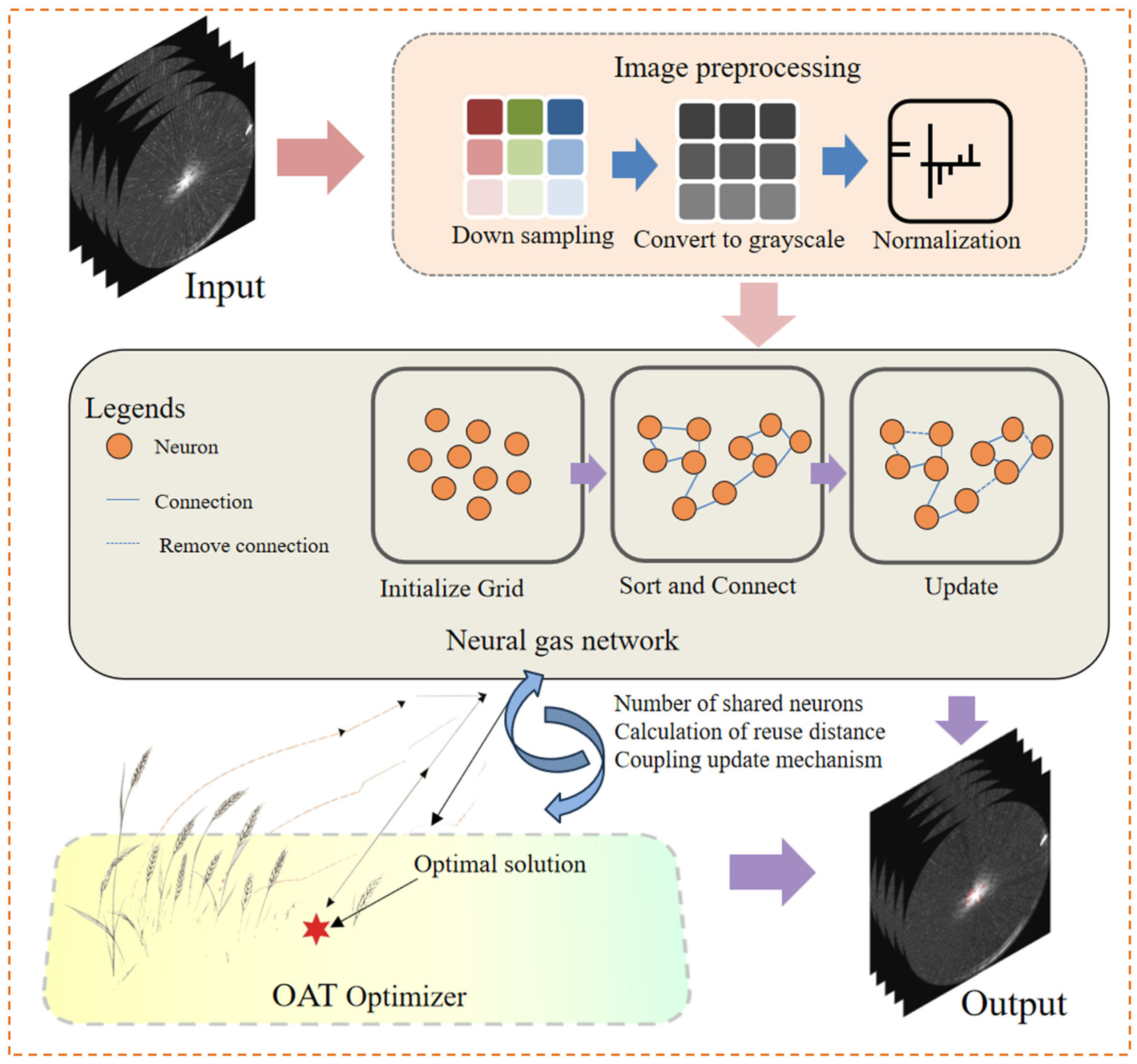

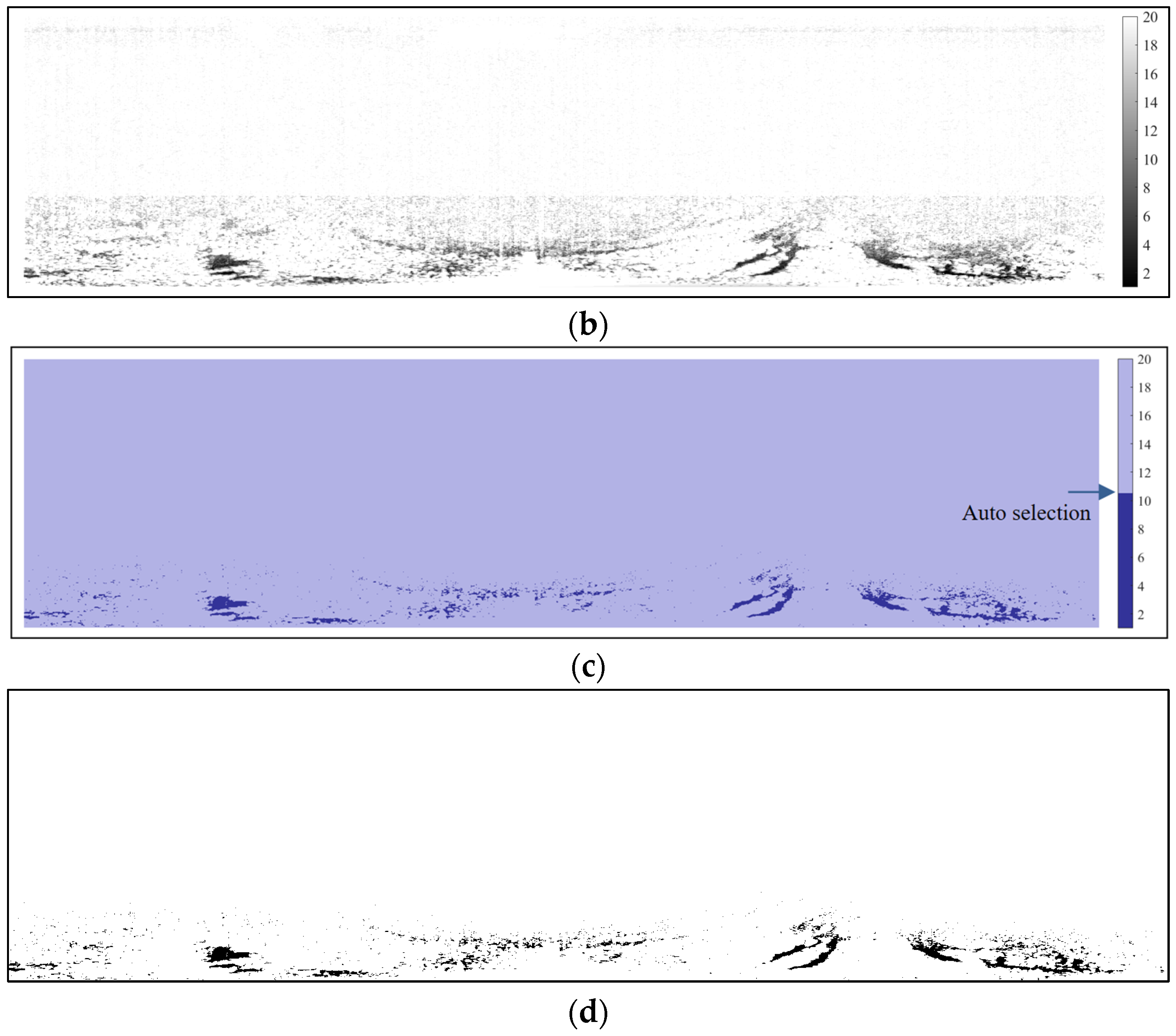
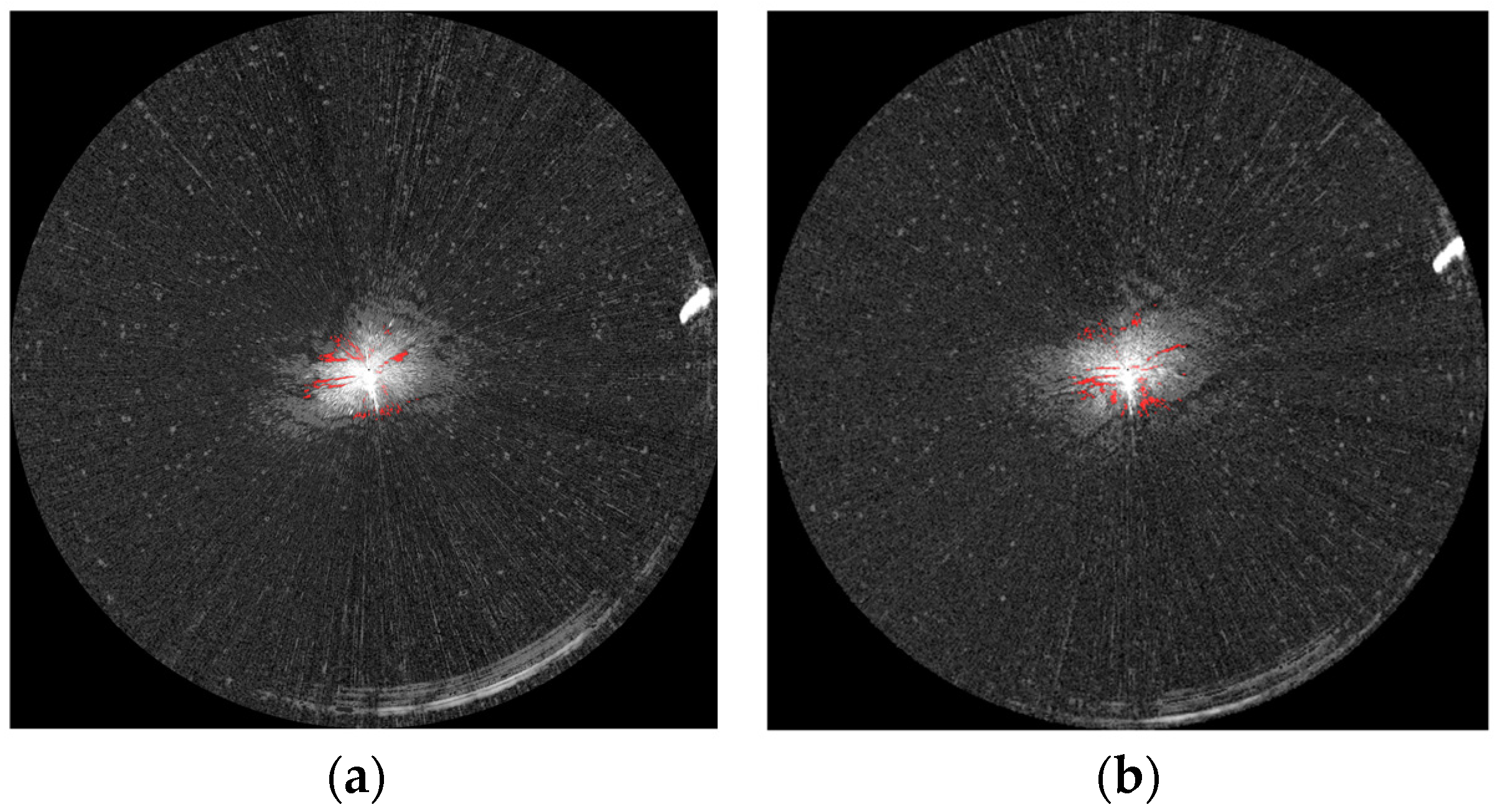

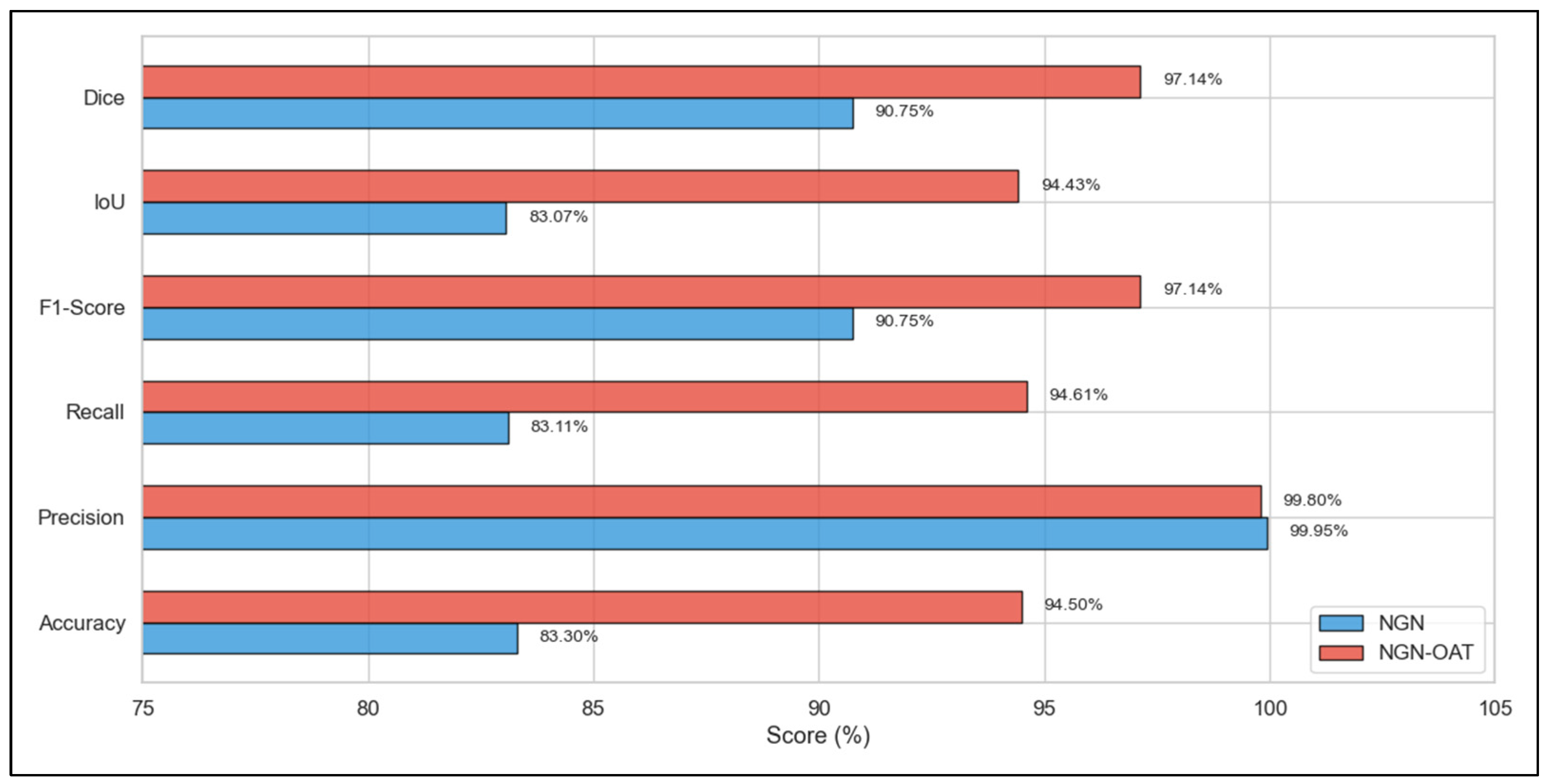
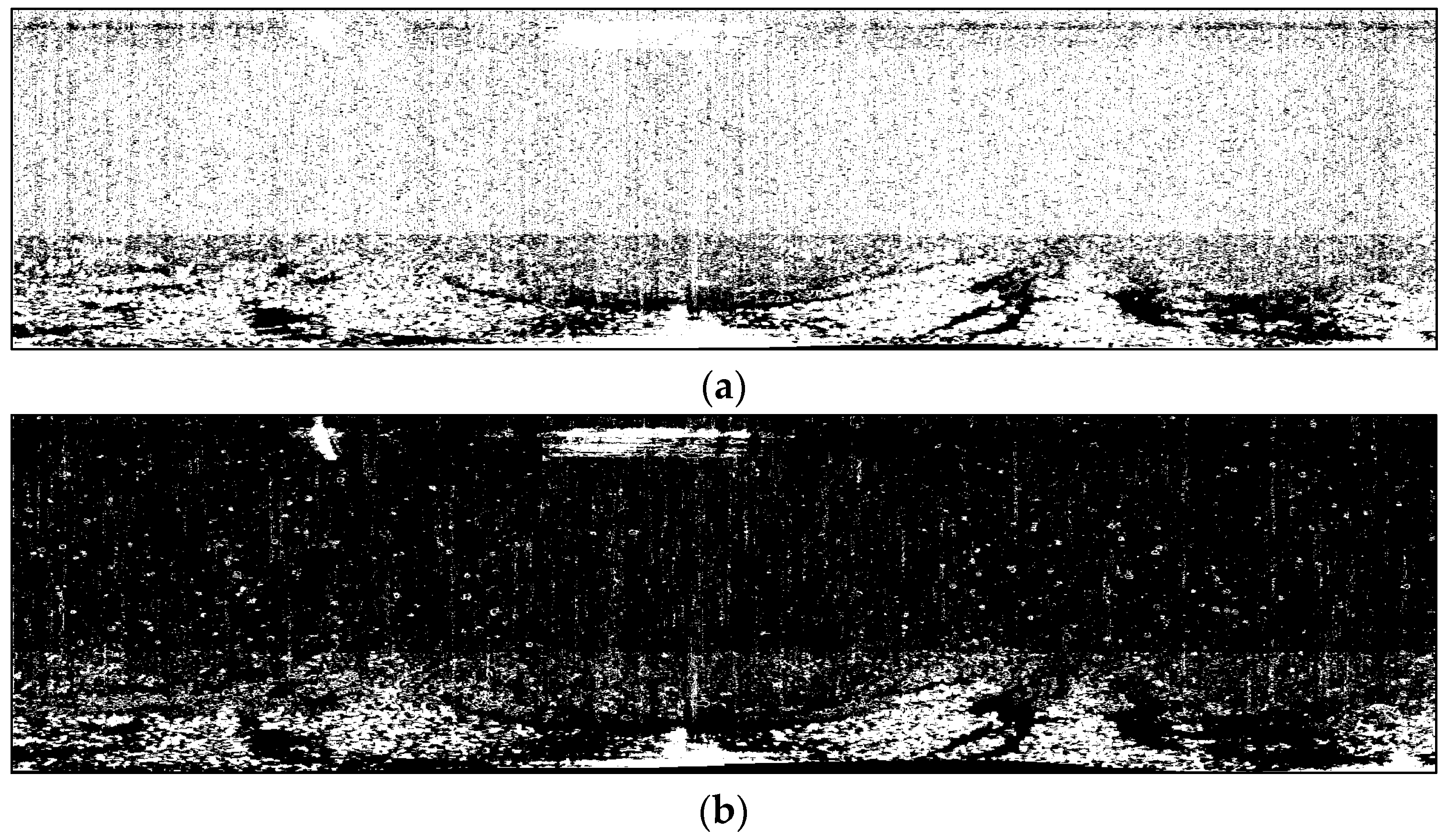

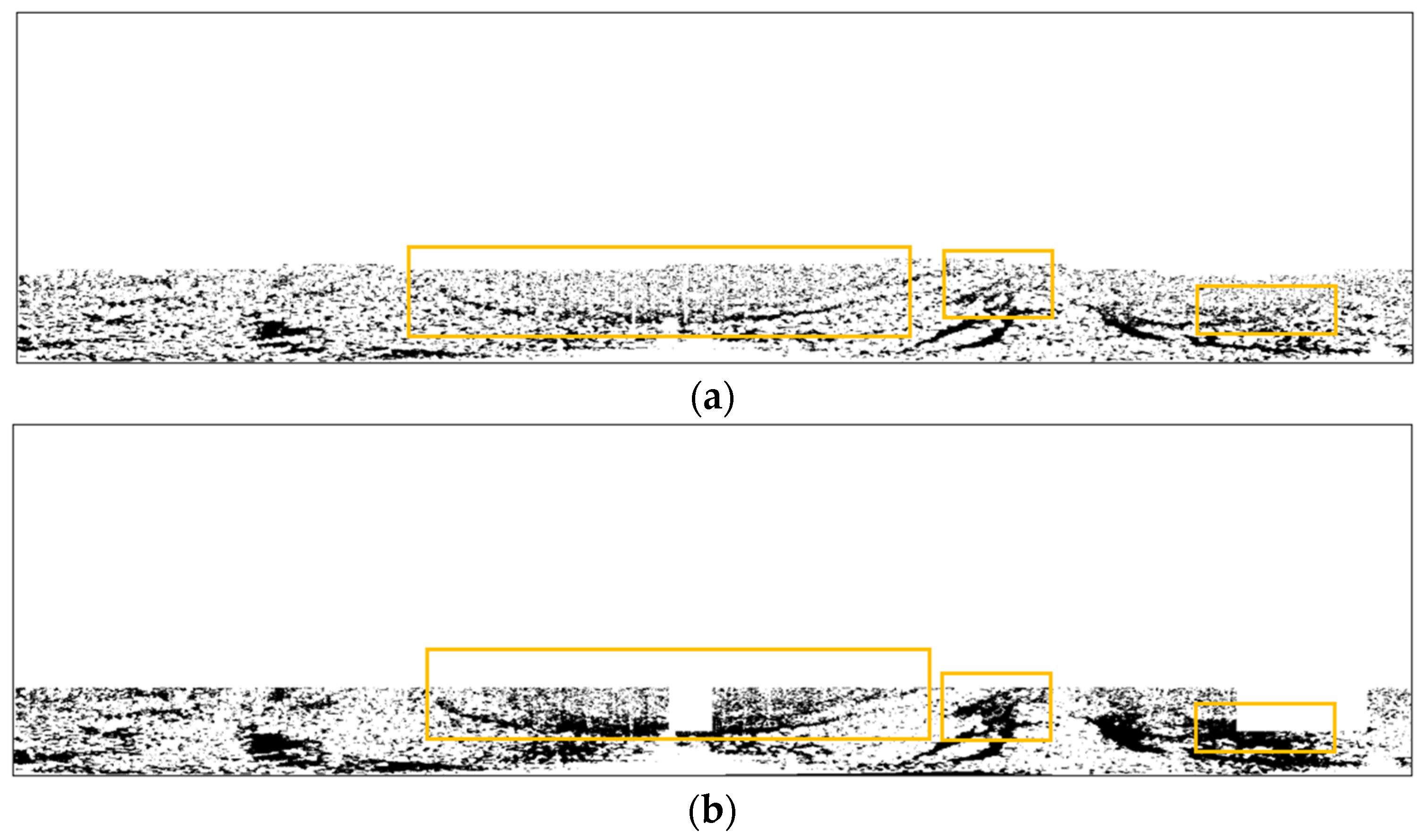
| Indicators | Performance |
|---|---|
| Accuracy | 94.50% |
| Precision | 99.80% |
| Recall | 94.61% |
| F1-score | 97.14% |
| IoU | 94.43% |
| Dice | 97.14% |
| Accuracy (%) | Precision (%) | Recall (%) | F1-Score (%) | IoU (%) | Dice (%) | |
|---|---|---|---|---|---|---|
| Our Method | 94.50 | 99.80 | 94.61 | 97.14 | 94.43 | 97.14 |
| Method 1 | 88.54 | 99.91 | 88.46 | 93.84 | 88.39 | 93.84 |
| Method 2 | 58.43 | 98.41 | 58.81 | 73.62 | 58.25 | 73.62 |
| Method 3 | 52.80 | 99.75 | 52.28 | 68.60 | 52.21 | 68.60 |
| Method 4 | 77.79 | 99.91 | 77.57 | 87.34 | 77.52 | 87.34 |
| Method 5 | 75.89 | 99.92 | 75.55 | 86.08 | 75.55 | 86.08 |
| Method 6 | 79.63 | 99.93 | 79.35 | 88.49 | 79.35 | 88.49 |
Disclaimer/Publisher’s Note: The statements, opinions and data contained in all publications are solely those of the individual author(s) and contributor(s) and not of MDPI and/or the editor(s). MDPI and/or the editor(s) disclaim responsibility for any injury to people or property resulting from any ideas, methods, instructions or products referred to in the content. |
© 2025 by the authors. Licensee MDPI, Basel, Switzerland. This article is an open access article distributed under the terms and conditions of the Creative Commons Attribution (CC BY) license (https://creativecommons.org/licenses/by/4.0/).
Share and Cite
Jia, B.; Guo, Z.; Xu, J.; Liu, P.; Liu, B. Neural Gas Network Optimization Using Improved OAT Algorithm for Oil Spill Detection in Marine Radar Imagery. Remote Sens. 2025, 17, 2793. https://doi.org/10.3390/rs17162793
Jia B, Guo Z, Xu J, Liu P, Liu B. Neural Gas Network Optimization Using Improved OAT Algorithm for Oil Spill Detection in Marine Radar Imagery. Remote Sensing. 2025; 17(16):2793. https://doi.org/10.3390/rs17162793
Chicago/Turabian StyleJia, Baozhu, Zekun Guo, Jin Xu, Peng Liu, and Bingxin Liu. 2025. "Neural Gas Network Optimization Using Improved OAT Algorithm for Oil Spill Detection in Marine Radar Imagery" Remote Sensing 17, no. 16: 2793. https://doi.org/10.3390/rs17162793
APA StyleJia, B., Guo, Z., Xu, J., Liu, P., & Liu, B. (2025). Neural Gas Network Optimization Using Improved OAT Algorithm for Oil Spill Detection in Marine Radar Imagery. Remote Sensing, 17(16), 2793. https://doi.org/10.3390/rs17162793










